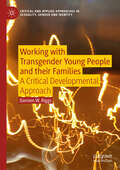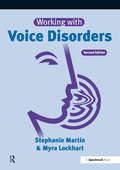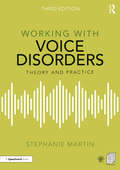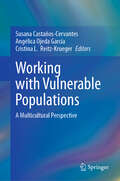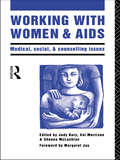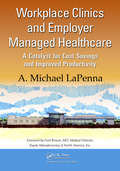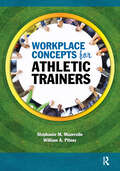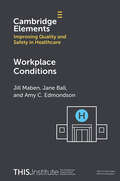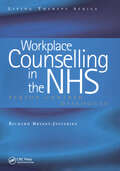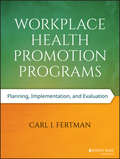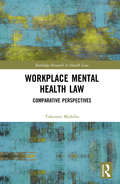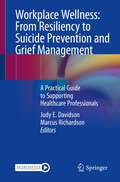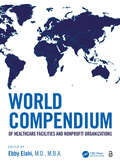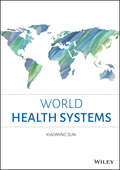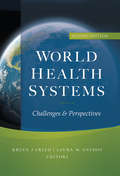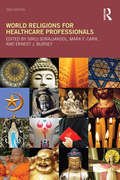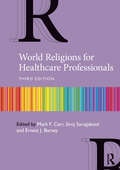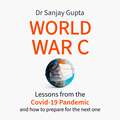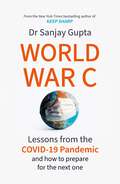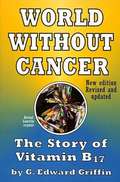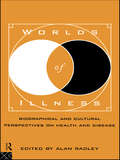- Table View
- List View
Working with Transgender Young People and their Families: A Critical Developmental Approach (Critical and Applied Approaches in Sexuality, Gender and Identity)
by Damien W. RiggsWorking with Transgender Young People and their Families advocates a critical developmental approach aimed at countering the cisgenderism that can be perceived in previous developmental literature on gender. It clears a path to understanding gender development for transgender young people by providing a detailed account that spans early childhood through to late adolescence. In doing so, it demonstrates how clinicians can work more effectively with parents and other family members in order to affirm transgender young people. By outlining a GENDER mnemonic created by the author, the book provides worked through examples of case materials that highlight the benefits of a critical developmental approach. Offering unique insights and practical guidance, it provides a cutting-edge resource for clinicians and researchers, as well as for families and other professionals seeking to understand and work affirmingly with transgender young people.
Working with Voice Disorders: Theory and Practice (Working With Series)
by Stephanie MartinAn essential resource for clinicians of varying levels of experience from student to very specializer, "Working with Voice Disorders" provides practical insight and direction into all aspects of voice disorders from assessment and diagnosis to intervention and case management. This second edition retains the successful format of mixing theory and practice, a melding of scientific knowledge with clinical art, which was such a feature of the first edition. In recognition of changes in practice and theory over the past decade, it contains a wealth of new, up-to-date, evidence based material. This blends with a practical approach to clinical efficiencies and management of the voice service. The second edition of "Working with Voice Disorders" provides a sound theoretical framework to this specialism and also offers a rich variety of tried and tested, practical and photocopiable resource material, which is the result of the authors' wide experience, accumulated over several decades in the field of voice therapy. The multi-dimensional structure of the manual allows the clinician to look, not only at specific aspects of patient management, but also at aspects such as clinical effectiveness, clinical efficiencies and service management. The authors' aim is that this resource should provide clinicians with a pragmatic, patient-centred, easy to use and accessible resource, facilitating and informing decision-making along the clinical journey from referral to discharge. The contents of this title include: Anatomy overview; The Spectrum of Voice Disorders; The Case History; Assessment; Treatment Strategies; Management Strategies; Service Provision; Over 50 pages of practical, photocopiable exercises. Photocopiable Appendices: Voice Care Advice; Voice Disorders Summary Chart; Voice Assessment Sheet; Voice Record Sheet; and, Voice Diary.
Working with Voice Disorders: Theory and Practice (Working With)
by Stephanie MartinNow in a fully revised and updated third edition, Working with Voice Disorders offers practical insight and direction into all aspects of voice disorders, from assessment and diagnosis to intervention and case management. Using evidence-based material, it provides clinicians with pragmatic, accessible support, facilitating and informing decision-making along the clinical journey, from referral to discharge. Key features of this resource include: A wealth of new, up-to-date practical and theoretical information, covering topics such as the prevention, assessment, intervention and treatment of a wide spectrum of voice disorders. A multi-dimensional structure, allowing the clinician to consider both specific aspects of patient management and aspects such as clinical effectiveness, clinical efficiencies and service management. Photocopiable clinical resources, from an at-a-glance summary of voice disorders to treatment and assessment protocols, and practical exercises and advice sheets for patients. Sample programmes for voice information groups and teacher workshops. Checklists for patients on topics such as the environmental and acoustic challenges of the workplace. Self-assessed personalised voice review sheets and weekly voice diaries encourage patients to monitor their voice quality and utilise strategies to prevent vocal misuse. Combining the successful format of mixing theory and practice, this edition offers a patient-centred approach to voice disorders in a fully accessible and easy-to-read format and addresses the challenges of service provision in a changing world. This is an essential resource for speech and language therapists of varying levels of experience, from student to specialist.
Working with Vulnerable Adults (The Social Work Skills Series)
by Jonathan Parker Bridget PenhaleThis text provides an understanding of current professional practice in social and health care, examining abuse of vulnerable adults and the ways in which social policy, welfare services and practitioners may compound or alleviate vulnerability. Working with Vulnerable Adults develops a sound basis for understanding issues of risk, vulnerability and protection and investigates how agency policies and procedures may, often unintentionally, lead to the voice of service users being marginalised or unheard. Drawing on recent and established research about the protection of vulnerable adults, the book covers: · Social work, social care settings and vulnerable adults · The concept of abuse and adult protection · Using the law in adult protection · Professional and quality assurance issues · Assessment in social work with vulnerable adults · Dealing with and managing vulnerability, risk and abuse · Adults with mental health difficulties, long-term conditions and learning disabilities · Community abuse and asylum seekers Much contemporary social and health care practice with adults is concerned with issues of risk and protection. Working with Vulnerable Adults provides information and knowledge for students and practitioners who are interested in finding out more about this important field.
Working with Vulnerable Populations: A Multicultural Perspective
by Susana Castaños-Cervantes Angélica Ojeda García Cristina L. Reitz-KruegerThis book explores vulnerability in many forms and among diverse understudied vulnerable populations worldwide from different perspectives, particularly from non-western contexts. It examines characteristics and profiles of vulnerable populations, intervention strategies, and recommendations for public policy actions in developing and emerging countries. As the world becomes increasingly connected and localities become more diverse, researchers and practitioners working to ameliorate human suffering cannot rely on one-size-fits-all solutions, especially when it comes to the most vulnerable members of society. The book argues the need for interdisciplinary research and action, and it challenges popular discourse on vulnerable groups and intervention strategies in Western societies and developed countries. In particular, it includes a Latin American perspective seldom considered in research about vulnerability worldwide. With interdisciplinary contributors from four continents, working in diverse fields such as social psychology, pedagogy, community psychology, medicine, sociology, clinical psychology, anthropology, and social work, this edited collection brings together theoretical and applied research evidence on three vulnerable population categories: physical vulnerability, psychological vulnerability, and social vulnerability. The book not only presents exhaustive solutions to any of the problems discussed therein, but it also offers examples of the considerations that should be afforded when working with groups who have unique vulnerabilities. Among the topics covered in the chapters: Poor Doctor-Patient Communication: How Social Vulnerability Turns into Physical Vulnerability Art Therapy: Focus to Decrease Vulnerability Condition and Increase Sense of Community Pedagogical Guidelines for Vulnerability in Postmodernity Working with Vulnerable Populations: Final Reflections and Implications Working with Vulnerable Populations: A Multicultural Perspective presents case studies, original research, and literature reviews that would engage students and professionals interested in social work, psychology, community organizing, public health, allied health professions, and other helping professions. Readers will gain insight into how work being conducted in various localities speaks to the challenges they may face in their own work or research. By exploring the unique issues facing vulnerable populations around the globe, we can apply those same considerations in our own communities.
Working with Women and AIDS: Medical, Social and Counselling Issues
by Val Morrison Judy Bury Sheena McLachlanWomen now account for one third of the ten million people with HIV infection worldwide. Yet until very recently most services were geared towards men, and doctors and other professionals were often unprepared for the particular issues that women would raise. Working with Women and AIDS provides a unique and readable combination of up-to-date medical information, a discussion of social issues, personal accounts and practical advice about ways of working with women affected by HIV and AIDS. Written by people working in the field, the book explores issues such as contraception, pregnancy and prostitution, which are of central concern to those involved in the care of the increasing number of women affected by HIV infection and AIDS.
Workout mit Baby: Was gut tut und fit hält
by Josef Kessler Constanze Bast-Kessler Jana KriegerFit nach der Geburt und ein zufriedenes Baby - das wünschen sich Mütter, Väter und Großeltern. Keine Zeit für das Fitnessstudio, keine Geräte zuhause? Das Kind will geknuddelt, bewegt oder beruhigt werden? Lassen Sie sich ein auf Übungen, mit denen Sie selbst mobil und stark bleiben und die Sie zusammen mit dem Baby ganz einfach durchführen können.Das Buch bietet mithilfe von Illustrationen Anleitungen für kurze Trainingseinheiten, die Sie spielerisch in den Alltag einstreuen können. Inklusive Aufwärmübungen, Muskeltraining und Dehnungen. Nebenbei erklären der Neuropsychologe und die Psychologin, wie sich das Kind nach der Geburt geistig und körperlich entwickelt und wie Sie fit bleiben, gemeinsam mit dem Baby viel Spaß haben und gleichzeitig dessen Motorik und Sinne ansprechen.
Workplace Clinics and Employer Managed Healthcare: A Catalyst for Cost Savings and Improved Productivity
by A. Michael LaPennaWorkplace Clinics and Employer Managed Healthcare: A Catalyst for Cost Savings and Improved Productivity is not another diatribe on the national healthcare problem. Instead, it is a book about what is possible. Mike LaPenna shares with readers the actual experiences of those self-funded employers who are moving healthcare access on-site and directl
Workplace Concepts for Athletic Trainers
by William Pitney Stephanie MazerolleAthletic trainers often find themselves immersed in organizations that can critically influence the way in which they fulfill their professional obligations. The workplace can offer many situations that are challenging, particularly for those athletic trainers who are transitioning into clinical practice.With that in mind, Workplace Concepts for Athletic Trainers provides readers with clear and meaningful information that addresses common concepts and issues that occur in the workplace. The topics selected are a reflection of those covered in the literature as problematic yet identifiable and manageable. Each chapter begins with learning objectives and includes a discussion of the issue itself, how it manifests (sources and antecedents), and strategies and solutions to address the concern.Inside Workplace Concepts for Athletic Trainers, Drs. Stephanie M. Mazerolle and William A. Pitney have infused each chapter with case studies to help readers apply the information presented. The conclusion of each chapter contains a summary, questions for review, and suggested readings to reinforce learning. The recommendations and information presented are designed to improve the workplace culture and climate and provide readers with practical suggestions for dealing with workplace issues.Included with the text are online supplemental materials for faculty use in the classroom.Workplace Concepts for Athletic Trainers is a must-have for any athletic training student transitioning into clinical practice or a clinician seeking help for common issues that occur in the workplace.
Workplace Conditions (Elements of Improving Quality and Safety in Healthcare)
by Amy C. Edmondson Jane Ball Jill MabenThis Element reviews the evidence for three workplace conditions that matter for improving quality and safety in healthcare: staffing; psychological safety, teamwork, and speaking up; and staff health and well-being at work. The authors propose that these are environmental prerequisites for improvement. They examine the relationship between staff numbers and skills in delivering care and the attainment of quality of care and the ability to improve it. They present evidence for the importance of psychological safety, teamwork, and speaking up, noting that these are interrelated and critical for healthcare improvement. They present evidence of associations between staff well-being at work and patient outcomes. Finally, they suggest healthcare improvement should be embedded into the day-to-day work of frontline staff; adequate time and resources must be provided, with quality as the mainstay of professionals' work. Every day at every level, the working context must support the question 'how could we do this better?' This title is also available as Open Access on Cambridge Core.
Workplace Counselling in the NHS: Person-Centred Dialogues (Living Therapies Series)
by Richard Bryant-JefferiesThis book has been written specifically to meet the needs of counsellors and trainers working with the National Health Service. It will also provide useful insights for doctors, nurses, and managers within the healthcare sector. The book covers topics such as, difference and diversity, colour, language barriers, oppressed nurses, stressed managers, changes in the NHS, exhaustion and late cancellations. Adopting the unique approach of the Living Therapy series, this book uses fictitious dialogues to enable the reader to directly experience the therapeutic process, providing real insight into the experience of workplace counselling in the NHS and also in other work settings.
Workplace Health Promotion Programs: Planning, Implementation, and Evaluation
by Carl I. FertmanShine a spotlight on the benefits of promoting health in the workplace Workplace Health Promotion Programs focuses on the incredible value that employee health programs can offer by exploring six key topics: behavioral health, physical health, healthy environments, health education, nutritional health, and physical activity. This in-depth resource explicitly establishes what successful workplace health promotion programs, services, and collaborations are, and then builds upon this foundational understanding by introducing methods and tools for promoting employee health and safety, while emphasizing the skills students need to do so. Through this resource, students will come to understand how to recognize employee health and safety opportunities, and how to think on a larger scale when it comes to workplace health initiatives in small, midsized, and larger employers that are comprehensive and fiscally sound. Workplace health promotion programs have the potential to both improve the health of the population as a whole and control healthcare spending in the process. Health problems are estimated to cost employers in the United States over $200 billion per year through medical costs, absenteeism, disability, and overall reduced productivity. Improving well-being through effective workplace health promotion programs can reduce this cost—and create healthier, happier workforces. Discover the design, implementation, and evaluation of workplace health promotion programs that address the range of employee health needs and concerns Understand how evidence-based programs can positively impact business and reduce health care cost Explore the larger scale implications of successful workplace health programs, including health policies, health insurance design, worker safety, employee behavior, etc. Learn how together employers and employees work to create a culture of health and well-being to support and promote employee health and safety Review the ways in which successful workplace health promotion programs can prove financially beneficial Workplace Health Promotion Programs is a resource that guides students and professionals alike in the discovery, development, and execution of successful employee health initiatives.
Workplace Mental Health Law: Comparative Perspectives (Routledge Research in Health Law)
by Takenori MishibaThis book provides a systematic and interdisciplinary study of occupational mental health legislation in seven countries. The work presents a study of the laws, policies, and legal interpretations to help prevent mental health problems from occurring in the workplace and appropriately address problems once they do occur. With a view to improving provision in Japan, the author examines the legal issues relating to workplace mental health and stress in the USA, UK, Denmark, the Netherlands, France and Germany. In presenting a comparative discussion of mental health issues in the workplace, this book seeks to establish a minimum for legal rights and duties that contribute to prevention and not just compensation. With its detailed comparative and descriptive coverage of legal and related provisions in a range of countries, the book will be a valuable resource for academics, policy-makers and practitioners working in labour and employment law, social welfare, occupational health and human resource management.
Workplace Wellness: A Practical Guide to Supporting Healthcare Professionals
by Judy E. Davidson Marcus RichardsonThis book uniquely provides actionable strategies along the wellness continuum in multiple dimensions: personal, institutional and professional; while applicable across disciplines: nursing and allied health, advanced practice providers and physicians. Further, the content is presented in a manner that can be taught to those entering the workforce, or serve as a primer for Wellness Officers. Most mental health texts focus on the needs of patients and ignore the mental health needs of clinicians. This book fills that gap embracing wellness initiatives as a matter of mental health. Wellness strategies for Inclusion Diversity and Equity are presented. The often ignored subject of suicide is approached head-on with evidence-based strategies for prevention. At the far end of the continuum of wellness, grief management after losing a colleague to death and/or suicide will be addressed. Each chapter includes learning objectives, a brief presentation of the science, application of principles into wellness practice, opportunities for future research and discussion questions. Artwork created by healthcare workers are included to augment transfer of knowledge through art as a way of knowing. Videos are offered to demonstrate through simulation lessons taught through the book.
Workplace-Based Assessments in Psychiatric Training
by Dinesh Bhugra Amit MalikIn psychiatry, as in many other medical disciplines, training is shifting from an emphasis on testing factual knowledge towards a system based on continuing assessment and the acquisition of practical skills and competencies. Workplace Based Assessments in Psychiatric Training describes current approaches to these new assessment systems around the world, provides practical advice regarding their implementation and makes recommendations for future developments. The book opens with an overview and analysis of methods of workplace based assessments, followed by a review of the trainee assessment from the patient perspective. Chapters contain in-depth, detailed discussion of recent developments in Canada, Denmark, India, the UK and the USA. The book reviews both technical developments in assessment tools and techniques and the socio-political context within which these have taken place. With a practical focus and unique global perspective, this is a 'must buy' for anyone responsible for the supervision of psychiatric trainees.
World Compendium of Healthcare Facilities and Nonprofit Organizations
by Ebby ElahiWorld Compendium of Healthcare Facilities and Nonprofit Organizations is the most comprehensive index of critical information on healthcare facilities and nonprofits in 72 low and lower-middle-income countries as classified by the World Bank. Presented in an easily accessible format and organized in 72 country chapters, the compendium allows stakeholders to better identify where healthcare services are available and where additional resources are needed.
World Health Systems
by Xiaoming SunYour all-in-one companion for health personnel World Health Systems details different health systems, including their related health insurance and drug supply systems, in various parts of the world with both macro- and micro- perspectives. The book is arranged in five parts: the first part presents, from multidisciplinary perspectives, outlines of various health systems throughout the world, as well as current trends in the development and reform of world health systems. The second and third parts expound on the health systems in developed countries, discussing the government's role in the health service market and basic policies on medication administration and expenses, before analyzing the health systems of Britain, Canada, Australia, Sweden, Germany, France, Japan, Poland, USA, Singapore, Hongkong (China), and Taiwan (China). The fourth and fifth parts discuss health systems in less developed countries and areas, typically the BRICS and other countries in Asia (Thailand, Vietnam, the Philippines, Armenia, and Kyrghyzstan), Africa (Egypt, Morocco), Europe (Hungary, Czech Republic, and Bulgaria) and South America (Cuba, Chile, and Mexico), summarizing their past experiences, while making assessments of their current efforts to shed light on future developments. Details a variety of health systems throughout the world Compares their fundamental features and characteristics Discusses their respective strengths and shortcomings Provides insight from an author who holds multiple impressive titles in the health sector Public health professionals and academics alike will want to add World Health Systems to their library.
World Health Systems: Challenges and Perspectives, Second Edition (AUPHA/HAP Book)
by Bruce FriedNew in the fourth edition: An update on the changes to Medicare coverage, including adding means testing on optional coverage for beneficiaries A new discussion of the legislation the current administration would like to implement for universal healthcare coverage A new focus on the quality-of-care debate and pay-for-performance incentives New requirements for not-for-profit hospitals to report services provided in order to validate their tax status An update on managed care and how universal coverage could change payment and delivery Updated information on biomedical research and the debate on whether the United States will remain a leader on this effort A new discussion of the effects of the current economic downturn on healthcare An updated discussion on the status of the healthcare workforce and how nursing and possible physician shortages will affect our system A discussion on healthcare expenditures and the estimated 47 million people who are currently uninsured A master bibliography has been created and is now located at the back of the book Updated glossary and acronym list
World Religions for Healthcare Professionals
by Siroj SSorajjakool Mark F Carr Julius J Nam Siroj Sorajjakool Ernest BurseyReligious beliefs and customs can significantly shape patients' and professionals' attitudes toward, and expectations of, healthcare, as well as their wishes and personal boundaries regarding such daily matters as dress, diet, prayer and touch. Undoubtedly, the sensitivity with which clinicians communicate with patients and make decisions regarding appropriate medical intervention can be greatly increased by an understanding of religious as well as other forms of cultural diversity. This second edition of a popular and established text offers healthcare students and professionals a clear and concise overview of health beliefs and practices in world religions, including Hinduism, Buddhism, Jainism, Confucianism, Taoism, Sikhism, Islam, Judaism, and Christianity. Adopting a consistent structure, each chapter considers the demographic profile of the community, the religion’s historical development, and key beliefs and practices, including views regarding health and sickness, death, and dying. Each chapter also ends with a useful checklist of advice on what to do and what to avoid, along with recommendations for further reading, both online and in print form. The book’s clear and consistent style ensures that readers with little background knowledge can find the information they need and assimilate it easily. A brand new chapter on applications and a set of new case studies illustrating issues in clinical practice enhance this wide-ranging book’s value to students and practitioners alike.
World Religions for Healthcare Professionals
by Siroj Sorajjakool Mark F. Carr Ernest J. BurseyThis third edition of a popular text introduces healthcare students and professionals to a wide range of health beliefs and practices in world religions. Chapters on various religions are written to offer an insider’s view on the religion’s historical development, key beliefs and practices, including ideas of health, sickness, death, and dying. The chapters include case studies, advice on what to do and what to avoid when caring for patients. Introductory chapters invite the reader to consider the broad context of patient care in pluralistic society and explore one’s personal orientation to others from different religions. How we care for patients from different backgrounds and cultures insists on professional boundaries that the reader may have not yet examined. A new chapter explores the relationship between religion and public health in light of the COVID-19 pandemic, asking the reader to consider what morally appropriate balance is required if and when personal faith conflict with public health needs. Undoubtedly, the sensitivity with which clinicians communicate with patients and make decisions regarding appropriate medical intervention can be greatly increased by an understanding of religious and cultural diversity. This is a core textbook for students studying healthcare, religion and culture, and an invaluable reference for healthcare professionals.
World War C: Lessons from the COVID-19 Pandemic and How to Prepare for the Next One
by Dr Sanjay GuptaCNN chief medical correspondent Dr. Sanjay Gupta, offers an accessible, data-packed answer to our biggest questions about Covid-19: What have we learned about this pandemic and how can we prepare for - or prevent - the next one?Frontline Covid-19 health journalist, Dr. Sanjay Gupta has barely left his primetime seat in his makeshift studio basement since the pandemic began (other than to perform brain surgery). He's had the insider of insider access to the drama's unfolding, including exclusive conversations with the world's top public health experts and behind-the-scenes scientists racing to find treatments and cures. And now he's sharing what he's learned in an audiobook that will answer not only all our questions about what happened, but also about how our world will change in the years ahead, even once we're back to "normal."As the doctor who's been holding America's hand through the crisis with compassion, clarity, and well-earned wisdom, he gives you the unvarnished story behind the pandemic, including insights about the novel virus's behavior, and offers practical tools to ready ourselves for what lies ahead. He answers critical questions: Can we stamp out the virus for good (and if not, how do we live with it)? Should we put our parents in a nursing home? Does it make sense to spend more on health insurance to deal with any long-term effects? How do you decide when it's safe to go to a public pool or schedule elective surgery? What should Covid survivors know about protecting their future health? What if you become a long-hauler with chronic health challenges stemming?World War C will give you hope for the future along with real information that leaves you more resilient and secure.(P) 2021 Headline Publishing Group Ltd
World War C: Lessons from the Covid-19 Pandemic and How to Prepare for the Next One
by Dr Sanjay Gupta'If there is any "must read" book about COVID-19, this is, without a doubt, the one.'Peter Jay Hotez, MD, PhD, National School of Tropical Medicine, Baylor College of Medicine'Drawing on his brilliant reporting from the front lines of the fight against COVID, Gupta has produced a book filled with hope and optimism that draws on the lessons of the recent past to give people a grounded sense of how to navigate the future.' Walter Isaacson, #1 New York Times bestselling author of The Code BreakerFrontline Covid-19 health journalist, Dr. Sanjay Gupta has had insider access to the unfolding pandemic, including exclusive conversations with the world's top public health experts and behind-the-scenes scientists racing to find treatments and cures. And now he's sharing what he's learned in a book that will answer not only all our questions about what happened, but also about how our world will change in the years ahead, even once we're back to 'normal'.As the doctor who's been guiding us through the crisis with compassion, clarity, and well-earned wisdom, he gives you the unvarnished story behind the pandemic, including insights about the novel virus's behavior, and offers practical tools to ready ourselves for what lies ahead. He answers critical questions: Can we stamp out the virus for good (and if not, how do we live with it)? Should we put our parents in a nursing home? How do you decide when it's safe to go to a public pool or schedule elective surgery? What should Covid survivors know about protecting their future health? What if you become a long-hauler with chronic health challenges stemming?World War C will give you hope for the future along with real information that leaves you more resilient and secure.'Part murder mystery, part practical how-to-survive guide, Dr Sanjay Gupta's World War C is a tour de force. In this riveting book, Sanjay divulges, as few others can, what you didn't hear about in the news during the pandemic, and equips us with the everyday tools to stay safe and chase life like never before.' Andy Slavitt, former senior advisor of COVID-19 response, Biden White House'With his characteristic curiosity, compassion, and humility, combined with unparalleled talent as a master-storyteller, Dr Gupta presents the defining history of the greatest public health catastrophe of our lifetimes. This is a must-read for how we can emerge stronger as individuals and as a society.' Leana Wen, Washington Post contributing columnist, former Baltimore health commissioner and author of Lifelines
World War C: Lessons from the Covid-19 Pandemic and How to Prepare for the Next One
by Sanjay GuptaCNN chief medical correspondent Sanjay Gupta, MD, offers an accessible, data-packed answer to our biggest questions about Covid-19: What have we learned about this pandemic and how can we prepare for—or prevent—the next one?As America&’s favorite frontline Covid-19 health journalist, Dr. Sanjay Gupta has barely left his primetime seat in his makeshift studio basement since the pandemic began (other than to perform brain surgery). He&’s had the insider of insider access to the drama&’s unfolding, including exclusive conversations with the world&’s top public health experts and behind-the-scenes scientists racing to find treatments and cures. And now he&’s sharing what he&’s learned in a book that will answer not only all our questions about what happened, but also about how our world will change in the years ahead, even once we&’re back to &“normal.&” Gupta argues that we need to prepare for a new era where pandemics will be more frequent, and possibly even more deadly. As the doctor who&’s been holding America&’s hand through the crisis with compassion, clarity, and well-earned wisdom, he gives you the unvarnished story behind the pandemic, including insights about the novel virus&’s behavior, and offers practical tools to ready ourselves for what lies ahead. He answers critical questions: Can we stamp out the virus for good (and if not, how do we live with it)? Should we put our parents in a nursing home? Where should we live? What should we stockpile? What should we know before taking a trip? Does it make sense to spend more on health insurance to deal with any long-term effects? How do you decide when it&’s safe to go to a public pool or schedule elective surgery? What should Covid survivors know about protecting their future health? What if you become a long-hauler with chronic health challenges stemming? World War C will give you hope for the future along with real information that leaves you more resilient and secure.
World Without Cancer
by G. Edward GriffinDedicated to the millions of cancer victims and their loved ones whose suffering has been the tragic cost of scientific arrogance and political vested interest. May the story presented in this book help to arouse an indignant public awareness which alone can break the hold of these deadly forces.
Worlds of Illness: Biographical and Cultural Perspectives on Health and Disease
by Alan RadleyIn recent years the study of illness as experienced by patients has emerged as an approach to understanding sickness. Descriptions of the everyday situations of people with particular diseases, provide a commentary upon the nature of symptoms and upon the relation of the body to society. This approach stresses the biographical and cultural contexts in which illness arises and is borne by individuals and those who care for them. It emphasises the need to understand illness in terms of the patients own interpretation, of its onset, the course of its progress and the potential of the treatment for the condition. Worlds of Illness examines people's experience of illness and their understanding of what it means to be healthy. The contributors are the first to offer this biographic and cultural approach in one volume, redefining the perspective further and drawing attention to its potential for questioning theoretical assumptions about health and illness.
